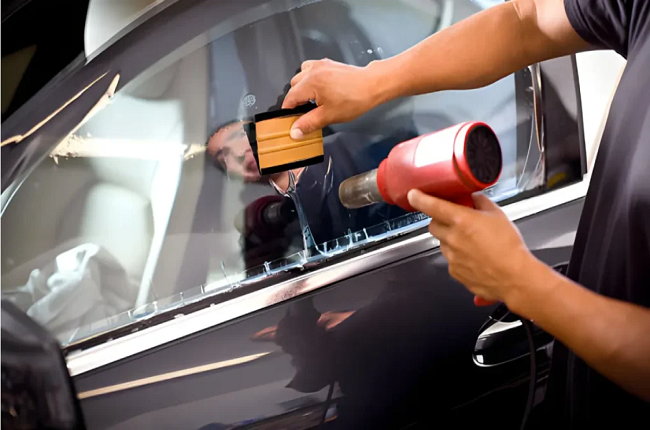
How to remove window tint serves a practical purpose, such as providing privacy, reducing glare, and protecting interiors from UV rays. However, over time, the tint can become damaged or outdated, prompting the need for removal. Whether you need to replace old tint or are simply tired of the look, how to remove window tint can be a simple and cost-effective process. By following these 5 straightforward steps, you can successfully remove window tint with minimal hassle, restoring your windows to their original condition.
1. Gather the Right Tools for Window Tint Removal
Before you start, it’s important to have the right tools at your disposal. Proper preparation is key for an efficient tint removal process. Here’s what you’ll need:
- Heat Gun or Hairdryer: These tools are crucial for loosening the adhesive holding the tint to the glass.
- Razor Blade or Utility Knife: To help peel the tint off without damaging the glass.
- Plastic Scraper or Credit Card: To scrape away any leftover adhesive without scratching the surface.
- Soapy Water: A mixture of dish soap and warm water to break down the adhesive.
- Adhesive Remover: A commercial product like Goo Gone for removing tough residues.
- Cloths or Towels: To clean up any messes and wipe down the windows once the tint is gone.
Having all of these tools ready will save you time and make the process smoother, so it’s always a good idea to gather them before you begin.
2. Heat the Window Tint for Easier Removal
One of the most effective ways to make tint removal easier is to use heat. Heating the window tint will loosen the adhesive, allowing it to come off more easily. Here’s how you can do it:
- Set up your heat source: Use a heat gun or a hairdryer. If you’re using a hairdryer, make sure it’s set to the highest heat setting.
- Apply heat evenly: Hold the heat gun or hairdryer about 3–4 inches away from the tint and start warming it up. Move the tool back and forth over the tint for a few minutes to heat the adhesive underneath.
- Work in small sections: Start from one corner and work your way across the window. Apply heat to small sections at a time to ensure the adhesive is softened enough for removal.
Pro Tip: Avoid overheating the glass to prevent cracks. A moderate amount of heat should be sufficient to loosen the tint.
3. Peel the Window Tint Off Carefully
Once the adhesive is loosened, it’s time to peel off the window tint. This step is crucial to avoid damaging the glass. Here’s how to peel the tint off without issues:
- Use a razor blade or utility knife: Starting at one corner, carefully insert the blade between the tint and the glass. Gently lift the corner of the tint, being cautious not to scratch the window.
- Peel in a steady motion: Once you have a corner lifted, slowly peel the tint off the window. If the tint tears, don’t panic; just continue peeling the remaining pieces.
- Use a plastic scraper if needed: If the tint breaks into smaller pieces, use a plastic scraper or an old credit card to lift the remaining sections. Avoid using metal tools, as they can scratch the glass.
Important: Take your time when peeling the tint. Rushing through the process can lead to uneven results or glass damage.
4. Remove the Residual Adhesive
After removing the tint, you will likely be left with some adhesive residue. This sticky substance can be tricky to remove, but don’t worry—it’s manageable. Here’s how to clean it off:
- Spray soapy water on the residue: Mix warm water and dish soap in a spray bottle and generously apply it to the sticky spots.
- Let it sit for a few minutes: Allow the soapy water to soften the adhesive. This makes it easier to remove without excessive scraping.
- Scrape off the adhesive: Use a plastic scraper or an old credit card to gently remove the residue. Be gentle, as scraping too hard can scratch the glass.
- Apply adhesive remover if necessary: For more stubborn adhesive, use an adhesive remover like Goo Gone. Follow the instructions on the product, as some may require you to let it sit for a few minutes before wiping it off.
Pro Tip: You can also use a mixture of vinegar and water as a natural alternative to adhesive remover.
5. Clean the Window for a Clear Finish
Once the tint and adhesive are gone, it’s time to clean the window. This final step will restore the glass to its original clarity, free from streaks and residue.
- Wipe down the window: Use a clean microfiber cloth to wipe down any remaining debris.
- Apply glass cleaner: Spray a generous amount of glass cleaner onto the window. Glass cleaner not only removes streaks but also gives the glass a shiny, smooth finish.
- Buff the glass: Use a dry microfiber cloth to buff the glass to a sparkling shine. This will ensure there are no streaks and leave the window looking brand new.
Final Tip: After the tint removal process, you may want to wait a day or two before applying new tint to ensure the window is completely clean and dry.
Alternatives Methods for Removing Window Tint
If the traditional method of heating and peeling doesn’t work for you, there are a few alternative methods for how to remove window tint:
- The Ammonia Method: Ammonia can break down the adhesive of window tint. Spray the ammonia onto the window, cover it with a plastic bag, and let it sit for a few hours. The tint should peel off more easily after this.
- The Steaming Method: If you don’t have a heat gun, you can use a steam cleaner to loosen the tint. Hold the steam cleaner over the tint and let the steam soften the adhesive.
- Professional Removal: For extremely stubborn tint or if you’re unsure about doing it yourself, a professional window tint removal service can do the job quickly and without damaging the glass.
While these alternative methods can be effective, they may take more time or require additional products, so make sure you’re comfortable with the process before trying them.
How to Remove Window Tint at Home Safely
If you’re wondering how to remove window tint at home safely, there are several techniques you can try with minimal tools. Using simple methods like heat guns or hairdryers, you can gently peel the tint from the window, ensuring no damage is done to the glass. It’s important to be patient and precise when following the steps, as rushing through the process could lead to scratched or cracked windows. By learning how to remove window tint at home, you can save on professional services and gain more control over the process. Remember, safety is key—ensure you’re in a well-ventilated area and take proper precautions.
Easy Way to Remove Window Tint Without Damaging Glass
If you want an easy way to remove window tint without damaging glass, the process involves careful use of heat and moisture. The goal is to loosen the adhesive that holds the tint in place, allowing you to peel it off smoothly. The right technique ensures that no harm comes to the glass surface while removing the tint. How to remove window tint with minimal effort is possible when using methods like a hairdryer or steam, which are gentle yet effective. Taking your time and avoiding any abrasive tools will ensure you maintain the integrity of your car’s windows. To see a complete guide on the process, you can check this step-by-step tutorial.
Best Method to Remove Window Tint Residue
When you’re done removing your window tint, you’ll likely encounter some stubborn adhesive residue left behind. Learning how to remove window tint residue is crucial for a flawless finish. Using a mixture of ammonia or a commercial adhesive remover can help dissolve the residue without damaging the glass. How to remove window tint residue effectively also involves using a razor blade carefully to scrape off any remaining bits. If you’re worried about damaging the glass, applying some heat beforehand can soften the adhesive. A thorough cleaning and polishing after this step will ensure your window looks as good as new.
FAQs about How to Remove Window Tint
How long does it take to remove window tint?
The amount of time it takes to remove window tint depends on the size of the windows and how easily the tint comes off. On average, you can expect to spend 1–2 hours for a single window, though it could take longer for larger or more stubborn areas.
Can I remove window tint without damaging the glass?
Yes! As long as you follow the right steps—using heat to loosen the adhesive, peeling carefully, and using the right scraping tools—your glass should remain undamaged.
How do I remove window tint from curved windows?
Curved windows can be a little trickier since the tint may not come off in one piece. Apply heat carefully and use a razor blade to lift small sections, working slowly around the curves.
Is there a way to avoid adhesive residue?
To minimize adhesive residue, be sure to use plenty of heat and allow the tint to loosen fully. The more thorough you are during the heating and peeling process, the less residue you’ll have to clean up.
Conclusion: How to Remove Window Tint Successfully
Now you know the five simple steps for easy success in removing window tint. Whether it’s peeling off old, bubbling tint or simply opting for a new look, following these straightforward steps will ensure the process goes smoothly. With the right tools, patience, and care, your windows will be looking clear in no time.
If you decide to replace your tint, make sure to choose high-quality tint film and apply it carefully. However, if you’re simply done with tinting, your car or home windows will be clear and clean after following these steps. Understanding how to remove window tint ensures that you can do it safely and effectively, saving you both time and money. Be sure to check out the tools and materials you need to make the job even easier, and remember—how to remove window tint is entirely achievable with the right preparation.
Additional Tip: If you’re in the mood for something celebratory, check out this Happy Birthday Daughter in Law greeting for a fun way to show appreciation on a special day!
You May Also Like:
The Extraordinary Life of Sam Hell: 5 Inspiring Triumphs and Struggles







